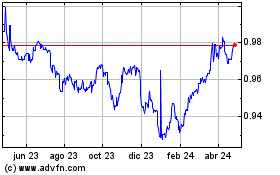German Factory Orders Decline Again Signaling Sluggish Start To 2019
05 Febrero 2019 - 9:38PM
RTTF2
Germany's factory orders unexpectedly decreased for a second
straight month in December and at a faster pace, on the back of
weak demand from abroad, suggesting that the slowdown in the
manufacturing continued and the sector likely had a sluggish start
to this year.
Manufacturing orders decreased a calendar and seasonally
adjusted 1.6 percent from the previous month, preliminary data from
the Federal Statistical Office showed on Wednesday, while they were
forecast to rise 0.3 percent.
The latest fall was the most since June, when orders shrunk 3.6
percent.
"The decline in orders in December indicates that the drought in
the industry is continuing for the time being," the economy
ministry said.
"The latest sentiment indicators also point to a subdued
industrial economy at the beginning of the year."
The monthly decline for November was revised to 0.2 percent from
1 percent reported initially.
Domestic orders decreased 0.6 percent and foreign orders fell
2.3 percent in December on the previous month. Demand from the euro
area grew 3.2 percent, while that from other countries declined 5.5
percent.
Orders for intermediate goods fell 1.2 percent and those for
capital goods decreased 2.5 percent. In contrast, demand for
capital goods grew 4.2 percent, largely driven by foreign
demand.
Excluding major bookings, factory orders climbed a 3.5 percent
from the previous month, signaling that the current situation was
not so depressing.
Compared to the same month a year ago, factory orders decreased
a working-day adjusted 7 percent in December following a 3.4
percent slump in November, which was revised from 4.3 percent.
Economists had expected a 6.7 percent decline.
In the fourth quarter of 2018, factory orders grew 0.3 percent,
the economy ministry said. Capital goods orders grew 2.8 percent,
as the automobile industry started making progress in tackling the
WLTP problem.
The automobile industry logged a 10.2 percent increase in demand
in the fourth quarter, while mechanical engineering and the
chemical industry registered declines of 0.4 percent and 1.9
percent, respectively.
"The inventory build-up in recent months, as well as the recent
drops in order books, suggest that any rebound of industrial
activity in Germany will be slow and sluggish," ING economist
Carsten Brzeski said.
"Looking ahead, we still expect the bottleneck in the German
automotive industry to be resolved in the coming months," he
added.
Germany likely avoided a technical recession in the fourth
quarter, the economy ministry has said. Average annual growth
slowed to a five-year low of 1.5 percent in 2018.
The latest purchasing managers' survey from IHS Markit showed
that the manufacturing sector shrunk in January, marking the
weakest level in 50 months.
Euro vs CHF (FX:EURCHF)
Gráfica de Divisa
De Mar 2024 a Abr 2024

Euro vs CHF (FX:EURCHF)
Gráfica de Divisa
De Abr 2023 a Abr 2024
